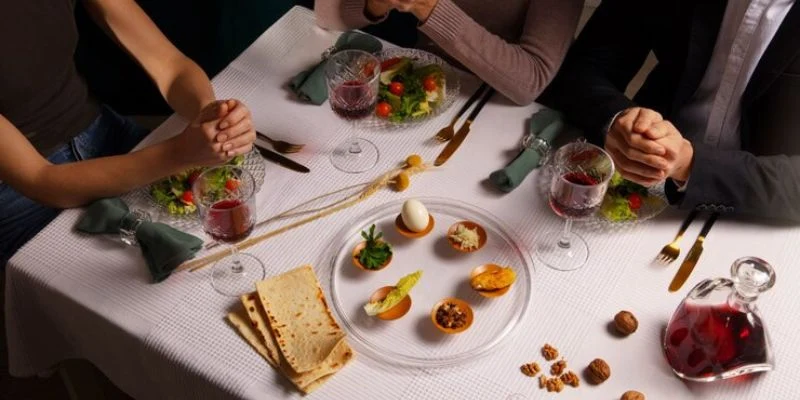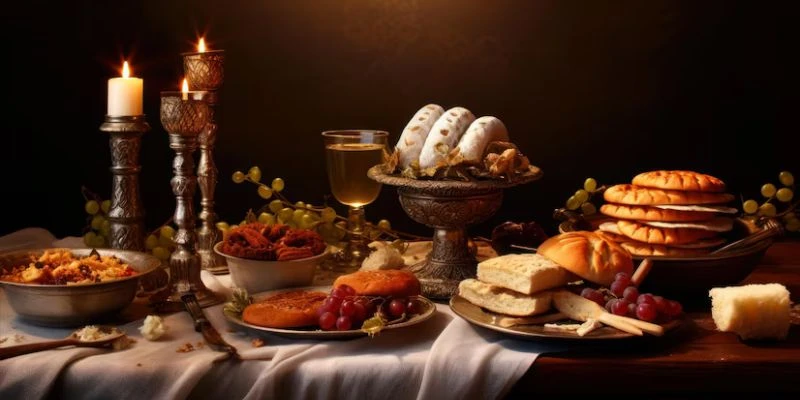Celebrating Passover: Everything You Need to Know
Updated: April 13, 2024
102
Each spring, a vibrant celebration explodes across Jewish communities worldwide. Passover, a joyous yet poignant holiday, commemorates the Israelites’ liberation from slavery in ancient Egypt. Steeped in symbolism and tradition, Passover transcends a simple historical event. It is a powerful story of resilience, faith, and the fight for freedom.
Over eight days, families gather to recount the exodus, partake in a special ritual meal called a Seder, and devour matzah, a flatbread symbolizing the haste of the escape. Passover is a time for reflection, gratitude, and delectable meals – a powerful reminder that hope and freedom can prevail even in the darkest of times.
Importance of Passover in Judaism
Passover, a week-long spring festival, holds immense significance in Judaism. It is not just a celebration but a powerful retelling, a reawakening, and a cornerstone of Jewish identity.
At its heart, Passover commemorates the Israelites’ dramatic liberation from slavery in ancient Egypt. The story, recounted in the Exodus, narrates how a ragtag group of enslaved people, led by Moses, defied a mighty pharaoh and journeyed towards freedom.

Passover is more than just a historical event, though. It is a vibrant tapestry woven with themes that resonate deeply with Jews across generations. Here’s why Passover remains so important:
Celebration of Freedom
The core message of Passover is the triumph of freedom over oppression. It is a joyous declaration that liberation is possible, even in the face of seemingly insurmountable odds.
Family and Community
Passover is a time for families and loved ones to gather around the Seder table. The holiday fosters a strong sense of community and belonging through shared meals, storytelling, and rituals.
Transmission of Tradition
The rituals and symbols of Passover serve as a powerful tool for transmitting Jewish history and values from one generation to the next. By actively participating in the Seder, children learn about their heritage and connect to their past.
Empathy and Social Justice
The story of the Exodus reminds Jews to empathize with the struggles of the oppressed. It’s a call to action to fight for justice and freedom, not just for themselves but for all who are downtrodden.
Renewal and Hope
Springtime coincides with Passover, symbolizing rebirth and new beginnings. The holiday serves as a reminder of the constant cycle of liberation and the importance of maintaining hope for a better future.
What is Passover
Passover, also known as Pesach in Hebrew, is a vibrant spring festival bursting with symbolism and tradition. Celebrated by Jews worldwide, it commemorates the Israelites’ dramatic escape from slavery in ancient Egypt. The story goes that after enduring generations of harsh treatment, God intervened through the prophet Moses, sending ten devastating plagues upon the Egyptians.
The final plague, however, miraculously “passed over” the homes of the Israelites, marked with lamb’s blood. This act of distinction is where the holiday gets its name. With newfound freedom, the Israelites fled Egypt so haste that their bread dough couldn’t rise, leading to the tradition of eating matzah, a flat, unleavened bread, during Passover.
Meaning and significance of Passover
Passover explodes onto the Jewish calendar each spring, a vibrant celebration bursting with symbolism and rich history. At its core, Passover commemorates the dramatic liberation of the Israelites from slavery in ancient Egypt. This pivotal event, recounted in the book of Exodus, became a foundational story for Judaism, shaping its identity and traditions.
The holiday’s name itself, Passover, signifies the “passing over” of God’s wrath on the Egyptians, who enslaved the Israelites. During the tenth and final plague, the Angel of Death struck down the firstborn sons of every Egyptian household. However, homes marked with the blood of a sacrificed lamb were “passed over,” sparing the Israelite firstborn.
Passover’s significance goes far beyond historical remembrance. It is a vibrant retelling, a chance for each generation to relive the experience of liberation. The centrepiece of the celebration is the Seder, a ritual meal brimming with symbolic foods and stories. Matzah, the unleavened bread eaten during Passover, represents the haste with which the Israelites fled Egypt, unable to wait for their bread to rise. Bitter herbs symbolize the harshness of slavery, while charoset, a sweet paste, represents the mortar used by the Israelites during their forced labour.
Passover transcends its historical roots. It is a universal message of hope and freedom. It reminds Jews, and by extension, all people, that even in the face of oppression, liberation is possible. It is a call to fight for justice and stand up for those who are downtrodden. The message of Passover resonates deeply, as it is a timeless reminder that the fight for freedom is an ongoing journey.
Passover 2024
This year, Passover begins at sundown on April 22nd, 2024, and lasts eight days. Celebrated by Jews worldwide, Passover commemorates the liberation of the Israelites from slavery in Egypt. The holiday is marked by a special Seder meal filled with symbolic foods, rituals, and stories that recount the Exodus. It is a time for families and communities to gather, reflect on freedom, and share the joy of new beginnings.

When is Passover 2024
In 2024, Passover falls on April 22nd, starting at sundown and lasting through April 30th.
| When is Passover 2024, the important day |
|---|
|
In 2024, Passover falls on April 22nd, starting at sundown and lasting through April 30th. This eight-day Jewish holiday commemorates the Israelites’ liberation from slavery in Egypt. It’s a joyous time filled with traditional meals, symbolic foods, and special rituals that celebrate freedom and new beginnings. |
What day is Passover 2024
Curious about when to mark your calendars for Passover this year? In 2024, Passover festivities begin at sundown on Monday, April 22nd, and conclude by nightfall on Tuesday, April 30th. So dust off your matzah box and get ready to celebrate the liberation of the Israelites from slavery!
Calendar date and significance of Passover 2024
This year, Passover falls on April 22nd, starting at sundown and concluding on April 30th. It commemorates the liberation of the Israelites from slavery in Egypt. The holiday celebrates freedom, marked by a special meal called a Seder, where symbolic foods and storytelling remember this pivotal moment in Jewish history.
Celebrating Passover
Passover bursts with joy and tradition. Families gather for a special meal called a Seder, sharing stories and symbolic foods that vividly depict the Israelites’ escape from Egypt. Laughter mingles with the clinking of glasses as they raise a toast to freedom, remembering the past while celebrating the bright future.
Preparation and planning for Passover
Passover prep can feel like a whirlwind! But with a little planning, you can easily celebrate this joyous holiday. Start by clearing space in your pantry for special Passover foods. Then, tackle your guest list and menu. Will you host the Seder or attend one? Knowing this helps shape your shopping needs. Finally, remember the fun! Dig out your Haggadah, the story of Passover, and consider involving kids in decorating for the festive meal.
Traditional foods eaten during Passover
Passover commemorates the Israelites’ escape from slavery in Egypt. Food plays a central role in this celebration, with each dish carrying a symbolic meaning that reflects the Exodus story. Let’s delve into some traditional foods enjoyed during Passover:
- Matzah
The star of the show! This unleavened flatbread represents the bread the Israelites couldn’t let rise during their hurried escape. Its simple texture serves as a reminder of their swift departure.
- Maror and Chazeret
These bitter herbs, usually horseradish and romaine lettuce, symbolize the bitterness of slavery and the harsh conditions the Israelites endured.
- Charoset
A sweet and symbolic mixture of nuts, fruits, wine, and spices. It represents the mortar used by the Israelites during their forced labour in Egypt. The sweetness offers a counterpoint to the bitterness of the maror.
- Karpas
A springtime vegetable, often parsley or celery, dipped in saltwater. It represents both the hope of spring and the tears shed by the Israelites during their captivity.
- Bein Harosets
This roasted shank bone or roasted egg symbolizes the sacrifices in the Temple in Jerusalem.
Beyond the symbolic foods on the Seder plate, Passover meals often feature delicious dishes that adhere to the holiday’s dietary restrictions. Popular choices include:
- Matzo Ball Soup
A comforting chicken soup with dumplings made from a matzo meal.
- Brisket or Roast Chicken
Hearty main courses symbolizing the celebratory sacrifices once offered in the Temple.
- Potato Kugel
A savoury casserole made with grated potatoes and onions.
- Tzimmes
A sweet and savoury stew featuring carrots, dried fruits, and sometimes sweet potatoes.
- Macaroons
Delicious and festive cookies made with coconut and other Passover-friendly ingredients.
Modern interpretations of Passover
In today’s world, many families are taking a fresh look at Passover traditions. While the core message of liberation remains, some are incorporating social justice themes into the Seder discussions, reflecting on modern struggles for freedom. Others are experimenting with new Haggadahs that explore contemporary issues alongside the ancient story of Exodus. This modern twist keeps the holiday relevant and engaging for younger generations, ensuring the traditions continue to evolve and resonate with future Passover observers.
How Passover is celebrated in different regions
Passover transcends borders. Every spring, Jews around the world celebrate the liberation of the Israelites from Egypt, but the traditions take on vibrant local flavours. Let’s embark on a journey to see how Passover unfolds in different regions:
In Ethiopia, the centrepiece is injera, a spongy flatbread that replaces matzah. They also hold a unique ceremony called “siman,” where a priest throws sticks to interpret the coming year’s fortune.
Italian Jews might surprise you with their sweet twist. Alongside matzah, they enjoy charoset, a mixture of nuts, fruits, and wine, often featuring chocolate!
Yemeni Passover tables boast a special bread called “kubaneh”, soaked in eggs and spices. A fragrant blend of coffee beans and aromatics called “haweej” fills the air.
Across the Atlantic, Moroccan Jews include tangy olives called “zeitoun” and a flavorful simmered vegetable dish called “tfina” on their seder plates.
When heading to India, we find fascinating customs. A separate cup of wine is poured, symbolizing the plagues and Pharaoh’s hardened heart.
Conclusion
As Passover draws to a close, we take a moment to reflect on the core themes of this ancient tradition. We remember the Israelites’ escape from Egyptian slavery, a testament to the power of resilience and the fight for freedom. The Seder meal was a powerful reminder of their past struggles, with each symbolic food representing a different aspect of the departure.
But Passover is not just a history lesson. In 2024, its message of liberation resonates deeply. New forms of oppression constantly challenge us, and Passover compels us to confront them. By remembering the past, we gain strength to advocate for justice and freedom for all, ensuring the enduring legacy of this sacred holiday.
Please Write Your Comments